photography by Kevin Wing
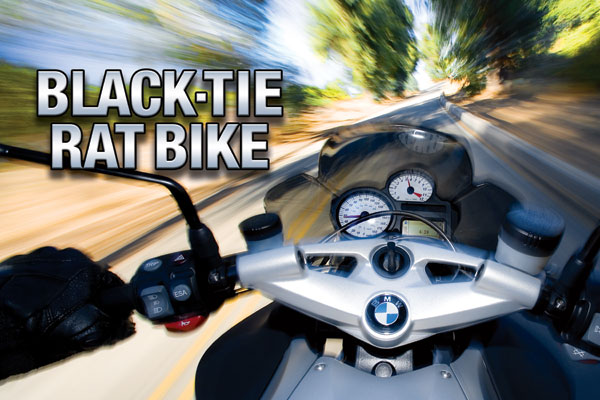 I look at the K1200R and wonder if a development test rider crashed a K1200S, stripping off the bike’s full fairing in the process, and upon righting it, the sight of the gangly machine laid bare inspired a designer to take pencil to paper and complete the transmogrification. Or if during the development of the K1200S Dave Robb, Director of Motorcycle Design for BMW–after a few snifters of Old Overholt, perhaps–happened to gaze upon a R&D mule yet to be cloaked in fairing plastic and, with a few strokes of his pen, connected its essential components with some minimalist styling pieces to create the ultimate Teutonic rat bike from hell, his Bavarian Frankenstein’s monster. I mean, just look at this thing! It is either the ugliest motorcycle to ever roll upon this earth, or the most beautiful. One thing’s for sure, it is not boring or lacking in character-and that’s before you start the engine.
I look at the K1200R and wonder if a development test rider crashed a K1200S, stripping off the bike’s full fairing in the process, and upon righting it, the sight of the gangly machine laid bare inspired a designer to take pencil to paper and complete the transmogrification. Or if during the development of the K1200S Dave Robb, Director of Motorcycle Design for BMW–after a few snifters of Old Overholt, perhaps–happened to gaze upon a R&D mule yet to be cloaked in fairing plastic and, with a few strokes of his pen, connected its essential components with some minimalist styling pieces to create the ultimate Teutonic rat bike from hell, his Bavarian Frankenstein’s monster. I mean, just look at this thing! It is either the ugliest motorcycle to ever roll upon this earth, or the most beautiful. One thing’s for sure, it is not boring or lacking in character-and that’s before you start the engine.
BMW calls the appearance of its wildest-looking motorcycle since the R1200C and its first new 2006 model “extroverted,” a fitting description of this outrageous naked sportbike. Essentially a K1200S caught streaking–maybe even mooning the BMW traditionalists–their 160-horsepower-plus engines, all-aluminum frames, weird Duolever front and functional Paralever rear suspensions, even the basic contours of the tank and seat, are identical. Instead of a tucked-in, streamlined sport tourer, though, the K1200R takes it right on the chin. In place of the fairing, we have merely a smallish windscreen, pair of halogen headlights, and the no-nonsense instrument panel from the R1200GS adventure tourer. Contoured covers barely conceal the tank-frame gap and radiator, and the front fender and tailsection were anti-aerodynamicized, treated to a nip/tuck as it were, because this naked bike has a higher drag coefficient and was meant to be quick but not fast.
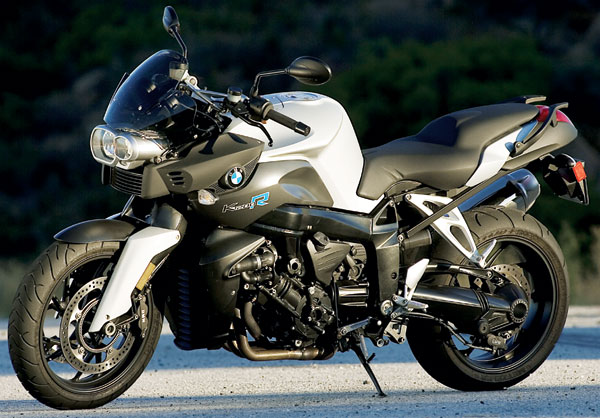 To that end the K1200R’s final-drive ratio is also slightly lower at 2.91:1 vs. 2.82:1. Leave the high top speeds to the K1200S and the autobahn–the K1200R was intended for urban assault. Its flattish cast handlebar–in place of the K1200S clip-ons–is higher, seating the rider more comfortably upright yet still leaning forward in an assured, moderately menacing way to fight the wind rather than slice through it. Footpegs are in the same reasonable spots, but the rider’s seat is narrower at the front, creating a two-position affair that is wide and comfortable at the back for long rides, yet lets you slide forward and hug the tank with your knees when you’re feeling frisky.
To that end the K1200R’s final-drive ratio is also slightly lower at 2.91:1 vs. 2.82:1. Leave the high top speeds to the K1200S and the autobahn–the K1200R was intended for urban assault. Its flattish cast handlebar–in place of the K1200S clip-ons–is higher, seating the rider more comfortably upright yet still leaning forward in an assured, moderately menacing way to fight the wind rather than slice through it. Footpegs are in the same reasonable spots, but the rider’s seat is narrower at the front, creating a two-position affair that is wide and comfortable at the back for long rides, yet lets you slide forward and hug the tank with your knees when you’re feeling frisky.
The same four-into-one exhaust and giant silencer as the K1200S gives the K1200R a similarly raspy but legal snarl, like the sound of a racebike being revved in a walk-in freezer. Instead of the usual de-tuning these engines often receive in the transfer from sportbike to street hustler, the new liquid-cooled, transverse K1200 four is identical in the S and R. The only difference is one intake snorkel on the R instead of two, which is probably why it makes about 7 percent less power. That still equated to a rollicking 135 horsepower and 81 lb-ft of torque at the rear wheel on the Borla Performance Dynojet dyno. Those peaks occur at roughly the same 10,000- and 8,500-rpm spots in the powerband, too, with more than 70 lb-ft of torque available from 4,000-10,000 rpm.
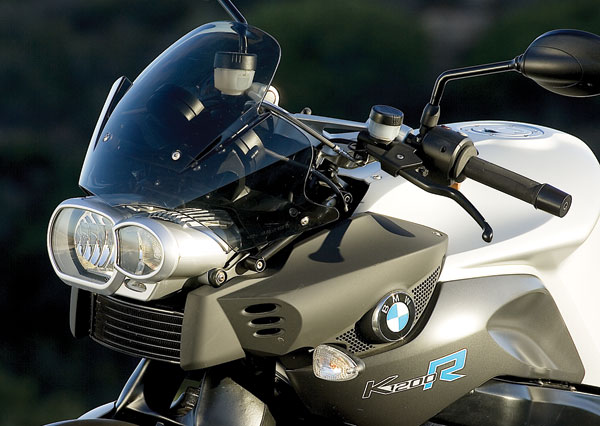
We’ve discussed the technological details of BMW’s new liquid-cooled, fuel-injected transverse in-line four in previous tests of the K1200S. Highlights include a radical cylinder-bank angle of 55 degrees to keep the center of gravity low, with a dry sump to shrink engine height-oil is stored in a tank under the seat. A pair of crank-driven balance shafts controls vibration, and electronic anti-knock control along with premium fuel allow a scary compression ratio of 13:1. Though making a tad less power in the K1200R, the naked bike also weighs about 10 pounds less, so all 135 ponies rarely get called into action. Power still gets to the rear wheel via BMW’s Paralever single-sided swingarm, too, making the K1200R one of the most powerful shaft-driven machines on the road.
Swing a leg over and the K1200R feels long and large for a naked sportbike, though its seating allows the rider to stretch out comfortably with a moderate amount of weight on feet and hands. It fires up readily with a growl, and throttle response is a pretty good compromise between abrupt and soft at most engine speeds. The bike is like a thoroughbred, though, in that it’s most happy at a gallop and up. Walking and trotting paces only annoy the high-strung engine, which has had its fuel injection well sorted since the first K1200S, but still bucks and surges a bit at low speeds, causing some driveline lash to rear its head. Upshifting is noisy at lower speeds, too, the front brake is grabby and the slightly over-taut steering damper causes the bike to weave a bit under 20 mph or so. The net effect makes you want to get outta town and onto the highway and faster back roads.
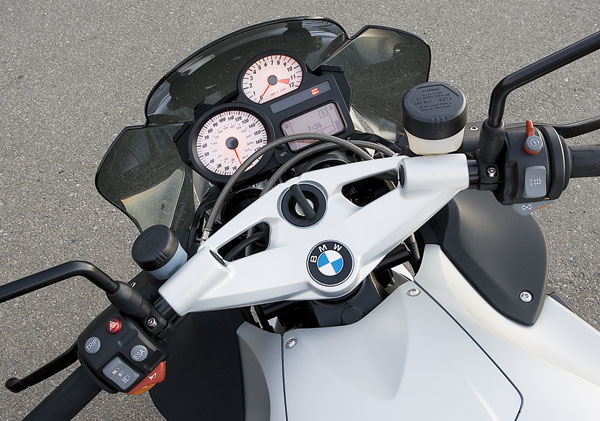
Once there, the K1200R is in its element. The small windscreen tames the blast well up to 85 mph or so (a taller, wider one is available), and even at higher speeds it’s easy to tuck in and get under it. Shifting smoothes out, steering becomes almost magical and the engine loves to be revved, quickly running through a buzzy rough spot between 6,000 and 6,500 rpm that is felt mostly in the grips. Acceleration is brisk from about 3,500 rpm, then downright maniacal above 7,000 to the 10,500 redline. Winding roads can be tackled in just third or fourth gear thanks to all that torque, leaving the rider to concentrate on lines and quickly slipping a knee left and right rather than shifting.
Comparable weight-wise to a Ducati ST4 ABS, BMW R1150R Rockster or Triumph Sprint ST, but making gobs more power, the K1200R has a stiff, massive all-aluminum perimeter frame keeping its wheels in alignment, with the engine as a stressed member. A lighter, stronger new single-sided Paralever shaft final drive pivots off the back of the six-speed transmission. Instead of telescoping legs the front wheel is carried between the ends of the new Duolever, a one-piece cast-alloy structure shaped like a tuning fork. This fork pivots both up and down and on its axis on a pair of arms, which in turn pivot vertically on the front of the frame. In between them is the strut which provides the spring and damping. Up above, the handlebar pivots in its own raised tower, and turns the fork through a jointed pair of arms that scissors in the middle as the fork moves up and down. It looks weird, but it works.
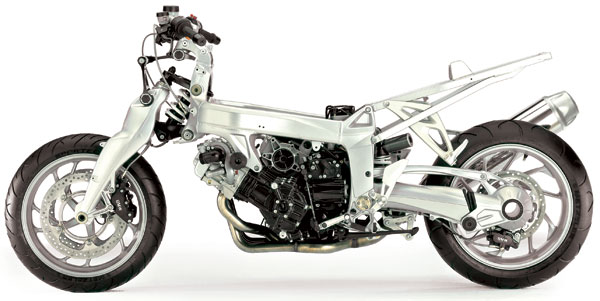
While the current BMW Telelever front suspension design is quite rigid and mostly eliminates the excessive braking dive, stiction and bump steer associated with telescopic forks, the Duolever system goes further by completely separating the suspension from the steering, nearly eliminating changes in the bike’s wheelbase during suspension movement. Our test bike was also equipped with BMW’s optional Electronic Suspension Adjustment, which replaces manual suspension adjustments with servos controlled from the handlebar. Front and rear compression and rear rebound damping can be changed among Comfort, Normal and Sport settings on the fly, and rear spring preload can be switched at a stop (with the engine running) among Solo, Solo with Luggage and Two-Up settings. ESA works wonders on this bike–it’s a must-have–and, unlike on the R1200RT, it doesn’t seem to raise the seat height. With my 29-inch inseam I could plant both feet on the ground easily at stops, and a 30mm lower seat option is available at no extra cost.
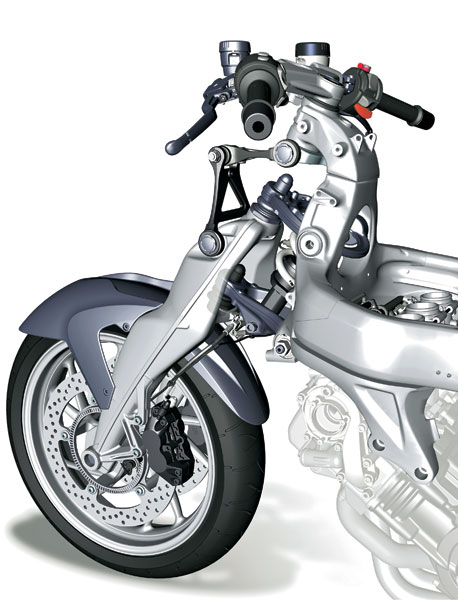
Our test bike also had the optional 6-inch-wide Sports rear wheel, 1/2-inch wider than stock, mounted with a fat 190/50-ZR17 Metzeler Sportec M1 instead of the stock 180/55-a 120/80-ZR17 Sportec rode up front. Even with this sticky but slower-steering combination and the K1200R’s longish 61.9-inch wheelbase, it turns quickly and predictably, yet still holds a line as well as its K1200S sibling. Some of the easy-steering manner is due to a slightly shorter wheelbase and tighter steering geometry than the K1200S, and some to the wider handlebar. In any case, combined with its high-performance suspension, sticky, excellent-handling rubber and neutral seating, the K1200R is wicked fast and fun to ride in the canyons–the Paralever prevents any shaft jacking from intruding on the fun, and cornering clearance is abundant. Yet the bike doesn’t crunch you up into a ball like some other more aggressive sportbikes. Despite its urban intent, the K1200R makes a really good sport-touring bike, with plenty of straight up-and-down comfort and on-highway smoothness.
Triple-disc brakes, with floating rotors and opposed four-piston calipers up front and a twin-piston caliper in back, are standard on the K1200R. The factory options list includes BMW’s Partial Integral ABS, which links the front and rear brakes when the front lever is used and adds an anti-lock function. Although the front lever on our test bike was grabby at low speeds, elsewhere the bike’s fantastic brakes are key to its quickness. Without any front-end dive, the bike can be slowed quickly enough to make you mildly nauseated from the negative Gs. I’d like to try them without the addition of Integral ABS to see if it eliminates the lever grabbiness, but leaving off the security of ABS would be a tough trade.
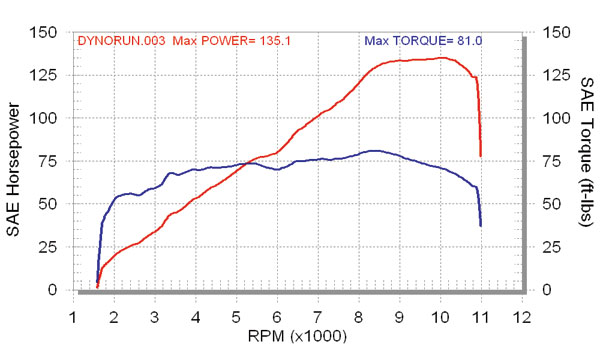
Standard goodies on the K1200R are few; that’s the idea. For your $14,250 it does come with good instruments and the Info Flatscreen, which provides all sorts of useful data like two tripmeters, a clock, fuel gauge and gear position. Adjustable brake and clutch levers with remote hydraulic reservoirs are standard as well. There’s quite a long list of factory options including Integral ABS, ESA and the Sports rear wheel, and dealer accessories count heated grips, locking side cases, a top trunk, a centerstand and a luggage rack among them. For sporting use, skip all of the options except perhaps the wider rear wheel-for sport touring, add the ESA, ABS, centerstand and maybe the luggage. Either way you’re getting a fast, fun, well-equipped Teutonic Frankenstein rat-bike-from-hell that’s ready for just about anything.








Good article! Both overall…i am looking to buy a used (30K kms) K1200 R 2006……wht is your global view a good purchase in 2020 at 5000$ ?
Where are you located? I have one with 15k miles I can let go for less than $5k.
This Dave from cape Girardeau, Missouri interested in your bike